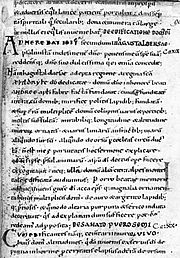Vita Sancti Wilfrithi facts for kids
Quick facts for kids Vita Sancti Wilfrithi |
|
|---|---|
| "The Life of St. Wilfrid" | |

A page from an 11th-century manuscript of the Vita Sancti Wilfrithi describing the foundation of Hexham Abbey
|
|
| Author(s) | Stephen of Ripon |
| Language | Medieval Latin |
| Date | Composed between 709 and c. 720 |
| Manuscript(s) | 1. London, British Library, Cotton Vespasian D. vi. Provenance: probably transferred from Yorkshire before it was held in Canterbury and then acquired by the British Library.
|
| Genre | Prose hagiography |
The Vita Sancti Wilfrithi or Life of St Wilfrid is an old book from the early 700s. It tells the story of Wilfrid, an important bishop (a high-ranking church leader) from a region called Northumbria in England. Even though it's a "life of a saint" (called a hagiography), it doesn't focus much on miracles. Instead, it talks about the church's politics in Northumbria and the history of two important monasteries: Ripon and Hexham.
This book is one of several important historical writings from that time. Others include the Vita Sancti Cuthberti and works by Bede. These texts help us understand how Christianity spread across Great Britain. This period is actually one of the best-documented times in English history before the time of Alfred the Great.
Contents
Who Wrote the Vita Wilfrithi and When?
The author of the Vita Wilfrithi says he is a priest named Stephen. For a long time, people thought his full name was "Eddius Stephanus." This idea came from the 1600s. However, many historians today don't think this is correct.
The confusion came because Wilfrid brought two music teachers from Kent to Ripon. Their names were Ædde and Æona. A writer named Bede also mentioned an "Ædde, also known as Stephen." He said this Ædde was the first music teacher in Northumbria. But many modern historians believe this Ædde was probably not the same person as the author Stephen.
We can be fairly sure that the Vita Wilfrithi was written between 709 AD and about 720 AD. Wilfrid died in 709. The book seems to quote from another text, the Vita Sancti Cuthberti, which was written around 720 AD. Some clues even suggest it was written after 716 AD.
What is the Vita Wilfrithi About?
The Vita tells the story of Wilfrid's life from when he was a boy until he died. It also mentions things happening at his two main monasteries, Ripon and Hexham. The book explains how Wilfrid decided to join the church as a boy. It talks about his disagreements with Theodore of Tarsus, who was the Archbishop of Canterbury, and with other powerful people.
The book also describes Wilfrid's many trips between England and Rome. It covers his involvement in church meetings called synods. A large part of the book (over one-third) focuses on Wilfrid's achievements in Northumbria. However, it doesn't say much about his second time as Bishop of York or his work in another region called Mercia. Like many stories about saints written soon after their death, this book doesn't include many miracles. But it does include important documents related to Wilfrid's story.
Challenges and Different Views
Some historians say that the Vita Wilfrithi is biased and takes Wilfrid's side. The book seems to look down on the contributions of the Gaels (people from Ireland and Scotland) to the church in Northumbria. It calls their ideas "poisonous seeds." This means it doesn't speak highly of places like Lindisfarne and other English monasteries connected to them.
The Vita gives Wilfrid all the credit for the Roman side winning at the Synod of Whitby. This was a big meeting where different Christian traditions in England decided to follow Roman customs. However, another important historian, Bede, tells the story differently. Bede makes Wilfrid seem less central to this victory. This makes it hard for historians today to know which account is more accurate.
Stephen's Vita describes the late 600s as a "golden age" for Wilfrid. But in Bede's book, Historia Ecclesiastica Gentis Anglorum, Wilfrid is just one of many church leaders who helped develop the English church. Because of these differences, some historians believe Bede wrote his book partly to offer a different view of history. He might have wanted to challenge the story told by Wilfrid's supporters in the Vita Wilfrithi.
Later Influence of the Vita Wilfrithi
The Vita Wilfrithi inspired a Latin poem in the 900s called Breviloquium Vitae Wilfridi. This poem was written by a person named Frithegod. It was created to celebrate when Wilfrid's relics (holy objects, often parts of a saint's body) were brought to Canterbury Cathedral around 950 AD. One historian, Michael Lapidge, has called this poem "one of the most difficult Latin poems written in pre-conquest England."

